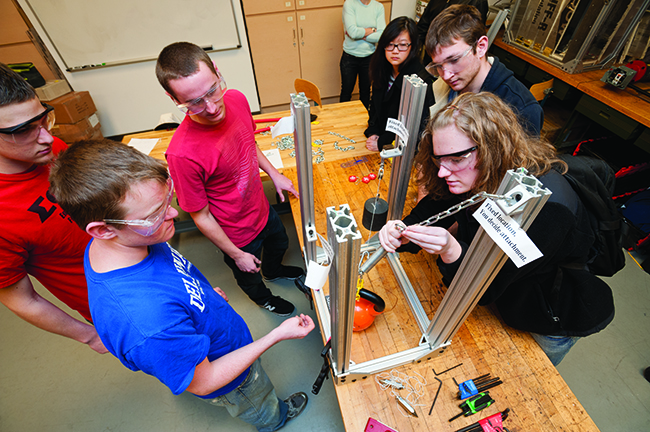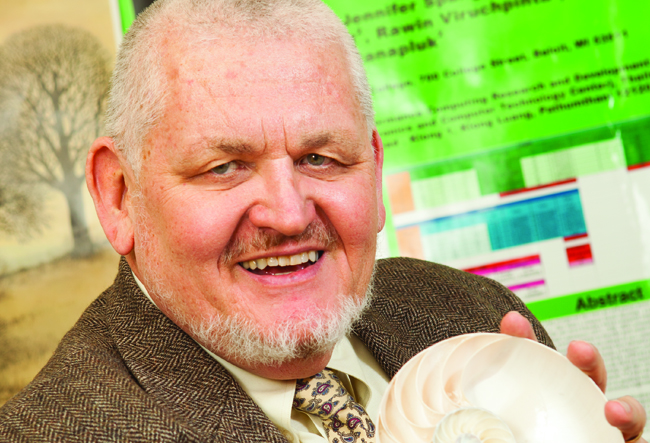



Deborah Allen taps her fingers on a massive biology textbook. It sits atop two others covering the same topic on a table in her office. She refers to these 1,000-plus-page tomes as student guidebooks.

The University of Delaware is nationally recognized as a leader in problem-based learning (PBL). The Institute for Transforming Undergraduate Education, established in 1997, teaches PBL techniques to educators.
Imagine a technology that simultaneously enriches the soil, neutralizes pollutants and removes carbon dioxide from the atmosphere. What would such a technology look like?
"They should make excursions into this, pull what they need and go from there," she says. The students in introductory biology courses already learned many of the fundamentals of the subject in high school. Allen says they need not repeat the basics in college; what they should be learning is how to think critically.
In her classes, Allen builds critical thinking skills through the problem-based learning (PBL) method. Traditional lectures featuring a professor behind a podium are replaced by problems to be solved and group work. PBL promotes inquiry, leading students to formulate their own scientific questions.
"That really is at the heart of science—knowing what is going to be a productive question," Allen says.
Next year, Allen will teach her Introductory Biology class in one of ISE Lab's four problem-based learning instructional laboratories. In each suite, two teaching laboratories adjoin a classroom, separated only by glass walls, so students can discuss a problem and then immediately test a solution.
This both physically and symbolically shifts the current paradigm. In traditional classroom settings, a faculty member or teaching assistant describes the week's experiment prior to the scheduled laboratory component, which takes place at a different time, often on a different day and in a different building.
Allen, a longtime UD professor became director of the Center for Teaching and Assessment of Learning after returning from a three-year leave of absence serving as a program director for the National Science Foundation's Division of Undergraduate Education.
Professional scientists and engineers, like those Allen worked with at NSF, are expected to think thesis-oriented thoughts. She believes problem-based curricula help students think the same way.
"You have an idea or an opinion and you can marshal evidence toward it. And, not only that, but you understand what the counterarguments are and you can counter them," she says.
For years, the University has worked to revamp its science and engineering curricula to emphasize real-world problem solving. Such curricula will best utilize the DuPont Science Learning Laboratories in ISE Lab, says George Watson, dean of the College of Arts and Sciences.
"The inquiry, the hypothesis building, to test and anchor ideas, are important parts of science," Watson says. "If laboratory instruction doesn't elevate that, then it doesn't accomplish what we'd like it to for our students."
The PBL approach is intended to make the classroom experience more engaging, and in turn, help recruit and retain students in science and engineering majors.
Students attending class in ISE Lab will regularly be asked to write and communicate orally, present concepts to the class and work in diverse teams; they will develop skills they will use daily in the future workforce.
At a time when online course offerings are increasing and a good deal of learning can happen virtually, the faculty, including Watson, who worked on plans for ISE Lab, wanted to create spaces optimized for active learning to provide what online learning alone can't.
"Sometimes students don't think science is relevant because they are not studying it in the context that they should be," he says.
Many engineers study basic biology, chemistry, physics and calculus freshman year and may not see how that first-year instruction connects to their career objectives. Many change majors. Watson says custom curricula fuse that connection by including examples and homework from students' chosen majors.
UD already has some of these courses in place; for instance, the mathematical sciences department offers special sections of calculus specifically for biology majors, featuring problem sets that connect the equations to a biological function.
So what do students think of problem- based learning? The student evaluations of Prof. Hal White's Introduction to Biochemistry course this past spring provided telling responses. White helped pioneer PBL at UD.
A student wrote: "I was apprehensive at first, but this course was very rewarding. The only course where the instructor has to tell the class to leave."—Andrea Boyle Tippett

John Jungck
John Jungck knew what UD was up to long before he arrived on campus. As a professor at Beloit College in Wisconsin, well versed in interdisciplinary, hands-on learning techniques, he knew the University by reputation for its leadership in problem-based learning (PBL), which emphasizes real-world problem-solving.
Last fall, Jungck became the director of the interdisciplinary learning laboratories in ISE Lab, a PBL-focused wing that has been named the DuPont Science Learning Laboratories.
"In order to do your work in today's age, it takes a village, it takes a team. How do we create a culture for our students that better reflects the kind of professional practice that occurs out there?" Jungck says. "When you talk to industry leaders, they're looking for problem solvers, team workers, people that can cross those boundaries and have an intelligent discussion with their peers."
Jungck says the inclusion of the word "interdisciplinary" in ISE Lab's name challenges faculty members on campus to rethink the way they teach.
"Architecture and schedules change people," he says.
No classroom inside ISE Lab holds more than 48 students. There are no lecture halls. Desks with wheels allow for flexibility of seating arrangements, easily transitioning from group to individual work and back again. All include the latest in educational technology. Some will have 3-D projectors. Using them, students can slice into a brain, look inside a molecule, examine geological formations in a stream or travel through an artery right from their seats. For young people raised on video games, these projectors help reinforce concepts in a manner they are accustomed to, as they explore unfamiliar material and over time morph from students into future members of the 21st-century workforce.—Andrea Boyle Tippett